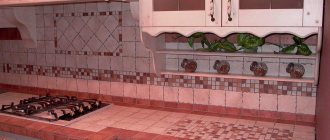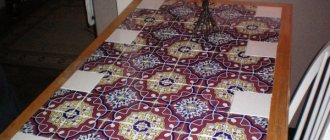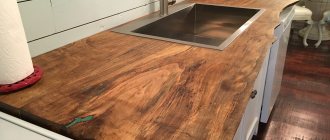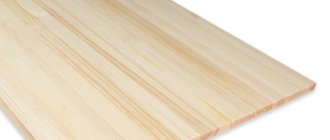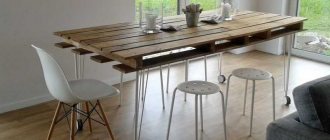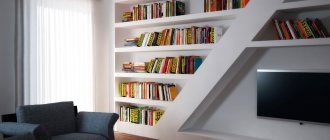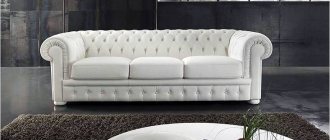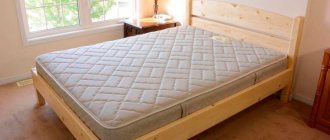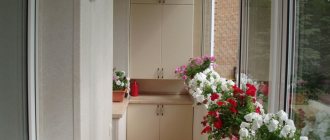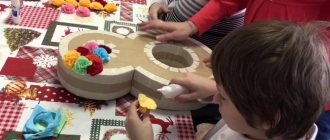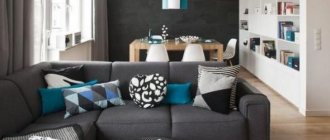Features of tile countertops
Finishing the countertop with tiles is a newfangled design solution. Such a surface will last for many years if you choose responsibly the material with which you will decorate the countertop. Stone or ceramic tiles are used to finish the work surface.
Kitchen countertop made of stone.
Stone countertops are usually made of marble or granite. This surface looks presentable and practical. But most often the work surface in the kitchen is made of ceramic tiles or tiles; these materials are much cheaper. It is better to use tiles when making countertops; they have a more convenient porous structure. To cover the kitchen surface, use squares with a diameter of 30×30 or 46×46.
IMPORTANT! The tiles need to be laid as close to each other as possible so that the seams can be masked (high-quality grout).
The most practical material for kitchen countertops is tile.
Stylish ideas from designers
The countertop sets the style for the entire kitchen interior, so the choice of artificial stone should be taken very seriously.
The countertop should match the design of the kitchen.
Designers give several recommendations regarding facing the work surface with porcelain stoneware.
- Clinker brick tiles look good in rooms in a minimalist style.
- Tiles that imitate wood will make a simple interior more comfortable.
- Glossy and polished tiles suit any design.
Tabletop made of porcelain stoneware imitating wood.
See alsoHow to decorate an ordinary glass jar with your own hands
Characteristics and types of countertops
Conventionally, tabletop models are divided into linear and angular. In addition, products can combine, for example, two tables with drawers and doors. The base itself, on which the tiles can be glued, can be made of wood or chipboard. As for the material of manufacture, the surface can be ceramic or porcelain stoneware.
According to the type of texture, it can be matte, polished, satin, lapped and glazed. In any line you can find a highly decorative option for designer finishing of the kitchen interior. For the base of the tabletop, you should buy moisture-resistant chipboard.
If you are planning to refinish an old countertop, it can easily become a countertop backing. In addition, it is worth using moisture-resistant plywood for the base.
A high-quality tiled kitchen countertop is strong and durable. This coating lasts a long time: its service life is calculated in years. At the same time, if all installation rules are observed, tiles can last on the countertop for more than 15 years. The material is resistant to water, it is easy to care for and can withstand washing with various household chemicals.
Thanks to the protective coating, the tiles are resistant to abrasion. It does not fade under the influence of ultraviolet radiation and for most of its service life it looks fresh, as if it had just been glued on. In addition, the material used to cover the tabletop is frost-resistant and has a different coefficient of friction.
The tile is a heat-resistant material, which is also important for the kitchen table.
Professional advice on choosing
Table top made of tiles (porcelain stoneware)
Preparation for countertop installation
- This is pouring a monolithic countertop.
- Make from gypsum boards.
Frame and tabletop assembly
Installation of tiles and washed down at 45 degrees
The tile countertop is ready!
Conclusion
- It’s labor-intensive, it takes a lot of time and effort to fit everything.
- It is difficult to repair if you accidentally hit the edge of the tile, it is very easy to chip off a corner, and replacing the tile is very problematic.
- Not cheap. If you order such work from a master, it will cost a lot. This work is not counted per square meter, but is counted by workdays.
- It looks beautiful and impressive. It’s very beautiful when both furniture and walls are made of the same material, especially natural textures.
- Care. The tiles are easy to clean and will not fade away, unlike wooden countertops. Resistant to water, it almost does not absorb water.
- Can be made to any size and shape.
- Advantages
- Self-production
- Preparing the base
- Features of wide format material
- Advice from professionals
- Care
- Reviews
- Place in the interior
Advantages and disadvantages
A tile countertop for a kitchen is both an aesthetic and practical choice. Not only does it look good, but it also holds up well under working conditions. The most commonly used materials are ceramics and tiles. The latter option has a more porous structure, while the former is easier to install.
Important! Traditionally, 15x15 tiles are used to lay countertops. The type of surface also deserves attention. It is better to make the working surface smooth and semi-matte. This way, dirt will not get stuck in the textured cracks, and scratches will be invisible.
Choose materials for the kitchen especially carefully. An excellent option is a countertop made of ceramic tiles. It is wear-resistant, durable and does not require special care.
Among all the options, porcelain stoneware is noted. The material is not afraid of high temperatures and excess humidity. It is characterized by increased strength, so it is not inferior to natural stone.
Thanks to its smooth surface, porcelain tiles do not absorb water, which allows them to be used for finishing bathrooms and countertops in the sink area. The material will fit into any design and add nobility to the interior.
What other advantages does tile have:
- Heat resistance and resistance to mechanical stress. You can safely place hot dishes on the countertop, there will be no marks left. High-quality installation will ensure strength and low susceptibility of the surface to damage.
- Hygienic coating. The tiled countertop is easy to clean with a cloth or damp cloth. It does not absorb fat and coloring liquids, and is not afraid of burning. In case of serious contamination, use soda and a hard sponge.
- Decorativeness of the material. A tiled countertop will delight the eye for many years. A variety of colors will allow you to choose a design for any interior. The tiles do not fade in the sun, so feel free to experiment.
- Versatility. A tiled countertop will easily fit into any style. It will help create unique compositions and become the main decoration of the headset.
In addition to the advantages, there are also disadvantages. The main drawback is the seams between the tiles. This finish will not create a smooth finish, so dirt will accumulate in the gaps.
To ensure that cleaning the seams does not turn out to be a big problem, high-quality grouting is carried out. The elements are laid as close to each other as possible to narrow the gaps.
Attention! Damage to any element of the countertop requires minor repairs. Replacing the part will not take more than an hour, so there is no need to worry. After 24 hours, the glue will be absorbed and the surface will be ready for use.
Advantages
An alternative to granite, durable tiles have a long service life. The material is resistant to mechanical damage.
It has an attractive appearance and allows you to decorate the room with beautiful furniture or decoration. A countertop made of chipboard or plywood, lined with porcelain tiles, has increased strength and resistance to high temperatures.
The load-bearing surface, after finishing with light-weight tiles, is not subject to deformation, so the advantage of porcelain stoneware is the possibility of laying on the following types of bases:
- metal;
- concrete;
- plastic;
- tree.
Initially, porcelain tiles were used as flooring, but the advantages of this material made it possible to use it for tiling kitchen furniture. The product is neutral to high and low temperatures, it is resistant to aggressive chemical compounds, and is easy to care for.
Porcelain tiles can be polished, and defects formed on its surface in the form of chips, cuts or scratches can be sanded with a special tool.
The advantages of countertops with porcelain stoneware cladding are as follows:
- environmental friendliness;
- heat resistance;
- moisture resistance;
- durability;
- practicality;
- maintainability.
The raw materials used to make the material do not contain harmful additives, dyes or artificial components, so its main advantage is environmental friendliness. The hardness of porcelain stoneware ensures the installation of high-quality countertops of various sizes, including the largest.
Heavy-duty surfaces allow you to cut food without using cutting boards.
The material is resistant to the penetration of fats or liquid substances, so its properties are preserved for decades. You can place hot dishes on the porcelain stoneware surface by removing them from the stove or taking them out of the oven . The tiles do not emit any toxic substances harmful to health, and bacteria do not multiply on it.
The functionality of porcelain stoneware allows countertops made from it to compete with many types of kitchen furniture made from other materials. Tiles are becoming an increasingly common material due to the wide range of colors available.
Expert opinion
Zakharov Igor Vyacheslavovich
Consultant at a furniture store. 5 years of experience.
Knowing the technology of surface cladding, it is easy to lay porcelain tiles with your own hands, even if you do not have the skills to work with this type of finish.
Types of tiles
To cover a kitchen surface, you need to choose glazed tiles with protection class 5. Kitchen tiles should not be afraid of grease, hot and cold objects, should not absorb moisture and should be easy to clean. There are a great variety of kitchen tiles, let's look at the most interesting options:
- Tiles imitating brickwork. These tiles are in the Italian and Provence style; they will fill the kitchen with warmth and comfort.
- Stone effect tiles. It will decorate the kitchen in Country and Classic styles, giving the kitchen individuality and novelty.
- I imitate leather on tiles. It will fill the kitchen with an atmosphere of chic and glamor. The imitation of snake and crocodile skin looks impressive.
- Tiles with crystals, painting or hand-decorated. These luxurious products are created for the rich decoration of the kitchen. They will give the interior uniqueness.
- Tiles with ornaments. They embody the most colorful and unusual design ideas. The kitchen will be decorated with patterns, prints, ornaments, drawings, and abstraction.
- Mosaic tiles. Gives off notes of oriental and Arabic interiors. It is very practical, but you need to take it with a reserve in order to select a design.
- Tile with photo printing. You can take any picture or photograph as an image. Thanks to special technology, the image on the tile does not erase, fade or drip.
- 3D tiles. It will add dynamics to the calm interior of the kitchen and make the design as interesting as possible.
- Tile with texture. Trend of the season: a glossy pattern is applied to a matte surface, it looks cool and tasteful.
- Figured tiles. The tiles are produced in the form of polygons, trapezoids, and round shapes. These tiles will turn your walls into a beautiful decoration.
What's better?
When choosing a particular material for covering a kitchen countertop, it is worth noting several factors.
- The decorative layer should be even and smooth. The porous texture is accessible to dirt, just like a mirror texture. Such tiles will have to be cleaned more often than others, and this often becomes a problem, since dirt quickly eats into the porous base.
- You need to buy dies of the optimal size, reducing the number of cuts. Ideally, it is preferable to cut only the end tiles.
- It’s better not to skimp on material and buy porcelain stoneware. It is resistant to abrasion, moisture, does not change properties when the temperature changes and is not susceptible to mechanical damage.
- Don't neglect buying a border. Such tiles significantly save the time of the entire cladding, including the time for adjusting and cutting edge dies.
How to choose the right porcelain tiles
When choosing porcelain tiles, pay special attention to the properties and dimensions of the tiles. A tabletop created independently can have different textures:
- Matte.
- Polished.
- Semi-matte.
- Embossed.
- Glazed.
Solid, but not heavy material allows you to install countertops of any size, even very large ones.
Glazed tiles have a mirror-like glossy finish, which is not particularly practical and requires special care. The smaller the tiles used, the more expensive the cladding of the product looks.
How to make a tile countertop with your own hands and what is needed for this?
When starting work, you should choose tiles that will look harmonious in the interior of the kitchen. If other surfaces in the room will be finished with tiles, then you should choose materials that are compatible with each other. Thus, you can make the interior holistic and harmonious without much effort. The color of the tile must certainly fit into the overall interior, and as for the size of the tile, you should definitely take into account the size of the room.
Advice. To finish the countertop in a large kitchen, you can choose tiles 30x30 cm or even larger, but for small rooms mosaic tiles (7x7 or 10x10 cm) are better suited.
Before purchasing a tile, you should study its properties and pay attention to the surface of the material. If you choose tiles for finishing the countertop:
- with a relief pattern, it will need to be washed more often, since dirt easily settles on its surface;
- with a smooth surface it will not look as beautiful, but at the same time it is easier to care for.
Advice. When choosing, focus on which tile you like best. Even if dirt appears sometimes, it can always be cleaned with detergents, a sponge or a brush.
Ceramic tiles for countertops Provenza Cevica Porcelain stoneware tiles can be a more expensive but reliable material. The material visually resembles tiles made of natural granite or marble, but at the same time it is more affordable and practical.
Attention! A porcelain stoneware countertop is heavy and should only be laid on a solid base.
In order for the tabletop to be securely fixed, it should be laid on a solid base. To do this, you should use thick sheets of chipboard. The chipboard base is laid already cut and has exactly the same dimensions and shape as the future tabletop.
Advice. Before fastening chipboard sheets using self-tapping screws, they must be treated with special means that will protect the material from moisture and rotting. Primers or impregnations (moisture-proof) must be applied strictly in accordance with the recommendations in the instructions. And only after complete drying can the sheets be attached to the cabinets for subsequent tiling.
Required tools and materials
To work you will need the following:
- spatulas for mortars (simple, rubber, with teeth);
- jigsaw;
- tile cutter;
- construction level;
- tile adhesive;
- grouting moisture-resistant composition.
Preparing the base
- As a base, you can take waterproof plywood - type FSF or FB with a thickness of at least 10 - 15 mm, it is laid in two layers. A simpler option is moisture-resistant chipboard with a thickness of 22 mm to 38 mm, then a layer of one sheet is enough.
- When calculating the dimensions of the tabletop, keep in mind that it should extend beyond the edges of the cabinets: 1 cm on the front side and 2 cm on the sides. Its standard width is 60 cm.
- It is very important to estimate the final height of the set, especially if the stove is not a hob, but stands separately. Is the height of its legs adjustable? Is it possible to align them?
- Next, the space for the sink and the panel, if any, is calculated. The holes are carefully cut with a jigsaw.
- Before assembly, all wood materials are additionally impregnated with a waterproofing compound and dried. The cutouts are processed more carefully, several times.
- If you are dealing with plywood, the first layer is attached to the cabinets with stainless steel screws, the optimal length of which is 38 mm. The caps must be completely submerged and treated with putty. The second sheet is glued to the first using wood glue or moisture-resistant PVA. Along the edges, the layers are fastened with self-tapping screws at a distance of 15 - 20 cm.
- In the case where the length of the plywood sheets is not enough for the entire set, try to overlap them so that the joints do not coincide. The halves are fastened together with side ties.
- The frame made of chipboard is fastened with self-tapping screws in increments of 10 - 15 cm.
Substrate treatment
To make a tile countertop for a kitchen with your own hands moisture resistant, it is treated with waterproofing agents. Silicone or acrylic sealant is applied to existing joints and cuts.
If the thickness is insufficient, 10 mm gypsum fiber sheets or cement-bonded particle board are used as a substrate for the cladding. They are fixed with tile adhesive, which is spread over the surface of the base with a notched trowel. However, this is not necessary, based on the thickness of the lid. Do not make the structure heavier and make it taller than 4 cm.
The key point before cladding is treating the base with a moisture-proof primer.
Laying tiles
Before gluing porcelain tiles, lay them out and figure out how the rows will be arranged.
- Vertical and horizontal lines are drawn through the center of the canvas. The layout can start from it, if there are cutouts - from them or from the most visible corner.
- It is better to place incomplete rows with cut tiles in the top row against the wall.
- The best option for attaching porcelain tiles to the base is epoxy tile adhesive. It is applied with a notched trowel to the base; there is no need to spread it on the briquettes.
- Dilute it in small quantities, especially if you have little construction experience. The glue sets easily, so at a low pace of work it quickly loses its properties.
- After installation, each tile is lightly pressed to the surface. The space between adjacent ones is indicated by a dividing cross. The width of the seam is selected depending on the size of the product; as a rule, it varies in the range from 1.5 mm to 4 mm.
- You can control the uniformity and quality of laying using a building level.
Laying tiles on the base
You can proceed to installation only after the base has dried thoroughly and been saturated with protective solutions. First, prepare a cement pad, which provides the future tabletop with strength and securely secures the structure. Acts as a screed.
Making a cement pad
The cement pad is laid as follows:
- A cement mixture is being prepared; it can be replaced with tile adhesive. Dilute the composition with water according to the instructions.
- Install beacons on the surface of the tabletop, which can be used to measure the distance. One is attached to the wall, the second - to the end of the future tabletop.
The tiles are carefully laid on the resulting pillow. Excess material is removed using a spatula. It is important that the pillow does not touch the walls.
Laying
The process of decorating with tiles is quite simple.
In order for the working plane to be level, special beacons must be placed on the surface.
The marking is done as follows:
- The middle of the future tabletop is measured. Two perpendicular lines are drawn - along the length and along the width.
- Apply the adhesive solution to the screed after it has completely dried. It is better to start from a visible corner so that the tile there is intact. Use a notched trowel.
- Place the tiles in even rows, following the markings. Correct the position using a building level.
- Leave cuts for edges and hidden areas.
How to cover the end of a countertop
The end should look aesthetically pleasing. The edge of the tile should protrude slightly beyond the edge of the cabinet, the remains of the product are cut and secured to the sides.
Grouting joints
Grouting is the final stage, necessary to finish the seams. It is better to choose a transparent material or grout that matches the color so that it is not visible on the surface.
The grout is applied using a rubber spatula and distributed evenly over the surface. The second way to remove excess is to apply masking tape and carefully tear it off the surface. This should be done no earlier than every other day.
We also recommend looking at - Epoxy grout Litokol
How to choose the style of the room?
The tabletop cannot be called a “capricious lady”. The surface of the table can effectively emphasize the sophistication of the kitchen set or “dissolve” against its background. It seems that the simplest solution would be to choose a countertop that matches the color of the facades. But it's not entirely simple. It is not always possible to find materials of the same shades.
There are no difficulties when installing monochrome furniture. But black will be sad, and white will be impractical. In this case, the set will visually look large and “monolithic”. To destroy these feelings, you will need bright decorative elements.
The choice of contrasting materials should be thoughtful and determined by the style of the room. A high-tech or minimalist interior can be decorated in black and white. A soft rustic mood will be better emphasized by a range of similar shades (sand/brown, white/blue, light green/green).
To create a harmonious environment, it is advisable to “link” the tiled countertop with other surfaces in the interior. A win-win way is to have the same finish on the table and window sill.
Romantic interior in Provencal style
The mild and sunny climate of the southern regions of France is associated with calm, pastel colors. Several characteristic features will emphasize the originality of the interior in a rustic style:
- the color scheme is formed by light pastel shades (sand, cream, white, beige, lilac, light green);
- you can lay out an interesting pattern on the work surface, but any combination of shades should not look provocative;
- Provence style assumes the presence of a variety of textile decor (curtains, tablecloths, pillows, upholstery). The shades of textile patterns should be reflected in the palette of the tabletop.
How to properly care for the surface
Maintaining a tile kitchen countertop is not that difficult. It should be wiped a couple of times a day with a damp sponge and detergent, and the choice of the latter will depend on the material of the tile. For example, granite will be highly resistant, and therefore acids and chemicals will not harm it.
After using the product, rinse the surface with water so that any chemical residue is completely washed away. The coating can last more than 10 years, and the materials are quite practical and also have an increased level of reliability. Ceramic tiles (if used correctly and without mechanical stress) can last up to 5 years.
Care
The porcelain stoneware countertop is cleaned for the first time immediately after the tiles are installed. Remains of glue and grout are first moistened with water and then removed with a weak solution of hydrochloric acid. This should be done with gloves so that the caustic liquid does not burn your hands.
Small stains can be removed with a dry or damp cloth. In more serious cases, acidic detergents are used.
Dirt on the surface of porcelain stoneware can be cleaned with a damp cloth or sponge.
Important! Do not use abrasive pastes or powders as they may damage the material.
See also: How to design a doorway without a door?
